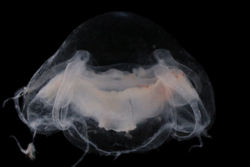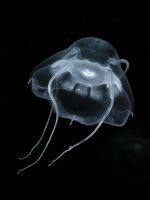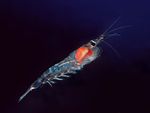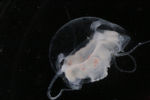Darth Vader jellyfish
| Darth Vader jellyfish |
|---|

|
| Scientific Classification |
| Scientific Name |
|
Bathykorus bouilloni |
| Closer look at the jellyfish |
The Darth Vader jellyfish is a species of marine jellyfish known by the scientific name Bathykorus bouilloni . It's common name comes from their shape which resembles the helmet worn Darth Vader in the Star Wars movies. In size, it only grows to about less than an inch and is partially blue and mostly transparent. They live in very deep in the Arctic Ocean and are unique in their life cycle from most jellyfish in not having the polyp and medusae stage.
Body Design
The Darth Vader jellyfish is transparent and partially blue. The mesoglea, transparent part, becomes thinner on the ends which results in its blue color. Although the mesoglea is thin, it is still firm.It's very small by only being less than an inch in diameter. [2]
It has four primary tentacles that resemble lightsabers. It has four secondary tentacles. These tentacles are about four or five centimeters in length. On the bottom of the secondary tentacles, there are sensory organs called statocysts. These help with balance. It's venom isn't harmful to humans.[3]The tentacles are located above the bell-shaped area of the jellyfish. The tentacles that hold the venom, hold it out in front of its belyl while swimming to catch prey more easily. These tentacles have an uneven distribution of nematocysts on the right-hand side. The nematocysts are a thread which contains the venom. Most jellyfish let their tentacles hang loose while swimming. In the tentacles, it includes three germ layers. The inside of the tentacles is made up of endodermal chordal cells.
The jellyfish also has twelve stomachs. The twelve stomachs are separated into four areas with three in each. The mouth is circular and leads to the stomach’s pouches. The pouches are either shaped in a rectangle or trapezoid shape with rounded edges.The stomachs can be shaped irregular by sometimes being square. The stomach's wall is thin with a yellowish tint. [2] Most jellyfish have bell shape for their body and they are called Medusae. This animal has been classified as its own genus because of its uniqueness.[2]
Life Cycle
A Darth Vader jellyfish first undergoes the larval stage, just like any other jellyfishes life cycle. Before developing into the larval stage, the sperm and eggs of two jellyfish come together. This results in a sexual reproduction. The cells divide which produces the larva. After this stage, the larva grows into an actinula. The actinuala continues the life cycle by developing more and more tentacles. As this stage continues, it buds some of the actinuala from itself. Then it grows into a minuscule jellyfish. The next stage does not occur in other jellyfish. Other jellyfish grow freely in the water. This jellyfish need to develop inside the body of an adult jellyfish, resembling human reproduction. They attach themselves to another jellyfish for nutrition and safety. However, it doesn't stay in that one particular jellyfish for its whole development. During their growth, they are like a parasite because they feed off of other jellyfish for their own maturation. Sometimes they will feed off of an entirely different species of jellyfish. After this stage is completed, they have become an adult jellyfish and then repeat this cycle. [4]
Ecology
In 2010, these small jellyfish were found deep in the Arctic Ocean.They were found by a rover looking for new species in the deep sea. Specifically one thousand meters down in the ocean.The Arctic Ocean feeds their need for freshwater.[3] It was found in the middle layer of the Arctic Ocean. It lives 1,400 in depts 2,000 feet. These jellyfish can’t survive very long outside of their habitat range. If not in their habitat, it results in death.Under these circumstances, it is hard to study them. [5] If you wanted it as a pet, they need to be kept at 34 degrees Fahrenheit for a week to adjust to the new enviorment. It is likely to be found in northern Canada and Greenland. [6] Its genus name comes from its habitat because the first part of Bathykorus refers to animals living in the deep sea. They cannot survive under the stress of a plankton net.
They get their food by using their tentacles. Their technique is called stealth predation because their tentacles stay in front of them while swimming. [2] They eat just about anything ranging from gelatinous animals to krill. Gelatinous organisms are ones with a jelly-like structure. Other organisms include worms, ctenophores, comb jellies, plankton, siphonophores, medusae, and about two dozen others. They have varities of food they can consume. These jellyfish play a huge role in the way they impact their environment. [7]
Other
The Darth Vader jellyfish looks like its name, Darth Vader. The shape of the jellyfish shaped like the helmet of the Star Wars villain, Darth Vader. However its size isn’t as imitating as Darth Vader himself because it only ranges to about two centimeters. Its tentacles are placed to look like Vader’s mouth and nose nubs too. Another resemblance is that this jellyfish can live in light conditions. It lives deep in the sea with no light, which means this animal is on the dark side just like Darth Vader himself. [5]
The jellyfish’s species name also has some uniqueness. The full species name is ''Bathykorus bouilloni''. Its name, Bathykorus, refers to its habitat and shape. "Bathy" means deep or depth and the Darth Vader jellyfish lives in the deep sea. The last part of the name, Korus, means helmet. This identifies to the helmet shape of the organism. It was named ''Bouilloni'' to honor a late doctor by the name of Dr. Jean Bouillon. His work reached sixty years and characterized seventeen families, thirty-four genera, and one hundred fourteen species. [2]
Video
Shows its movement.
References
- ↑ Marine Species. Bathykorus bouilloni Raskoff, 2010 . Web. Accesed May 13, 2018. Author Unkown.
- ↑ 2.0 2.1 2.2 2.3 2.4 Raskoff A., Kevin Bathykorus bouilloni: a new genus and species of deep-sea jellyfish from the Arctic Ocean (Hydrozoa, Narcomedusae, Aeginidae Mapress Web. Last Accessed April 14,2018.
- ↑ 3.0 3.1 Heaven, Douglas.Jellyfish as you’ve never seen them – meet the underwater aliens. Newscientist. Web. Publication Date July 13, 2016.
- ↑ Dunn, CaseyCreatureCast – Narcomedusae. Creature Cast. Web. Published September 19, 2012.
- ↑ 5.0 5.1 Hill, Kyle DARTH VADER JELLY IS THE SITH OF THE DEEP SEA Nerdist. Web. Published June 11, 2016.
- ↑ Bathykorus bouillon Astronomy to Zoology. Web. Last Accessed April 14, 2018.
- ↑ Klein, JohanneWhat eats what: a Landlubber’s guide to deep sea diningSeattle Times Web. published January 19, 2018.




